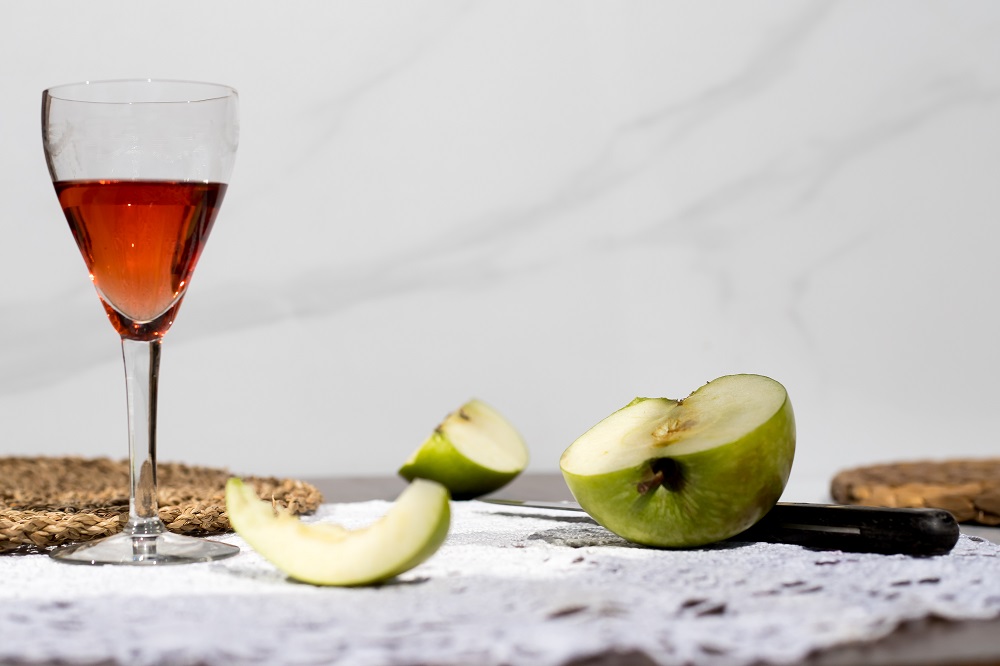We have all heard of apple cider and hard cider, but what about apple wine? The Alcohol and Tobacco TTB (Tax and Trade Bureau) has specifications for what is sorted into each category.
Any fermented apple juice that has less than 8.5% ABV (alcohol by volume) is known as hard cider. Any fermented apple juice with an ABV in excess of 8.5% is considered to be an apple wine.
What apples are used?
You cannot make hard cider or apple wine from regular eating apples. The apples used are specifically grown for the purpose of fermentation, as different characteristics are required of the fruits.
Apples to be fermented must be more acidic and have higher levels of tannins. They are sometimes referred to as spitters.
Tannins are a group of bitter compounds that exist in nature to deter animals from eating plants before they are ripe. You may have heard of them in terms of leather production, where they have been used for centuries.
Tannins are an important component of wine. They give the characteristic mouthfeel, structure, and weight to the drink.
They are sometimes described as creating a drying sensation. Red wine contains more tannins than white, which is why your mouth feels drier after drinking it.
You will need to combine these astringent apples with some sweeter varieties in order to create a nice-tasting wine. Be aware that even very sweet apples are much more acidic than grapes. Your apple wine will likely turn out to be very dry, so be aware of this.
Method 1: fresh apples
This method is very in-depth and requires a lot of research and knowledge. We advise checking out some other sites for a detailed description of this process.
Method 2: apple juice
This method is relatively simple and is a good place to start your apple wine-making journey. You will need to purchase a non-fermented juice to complete this.
This juice is often marketed as a non-alcoholic cider and should be relatively easy to find in grocery stores and farmers’ markets.
If you are using this method, you need to find an apple juice without preservatives added. In particular, you should keep an eye out for sodium benzoate and potassium sorbate. These will inhibit the fermentation process and mean you cannot make wine.
You will need to add some sugar to this juice, along with winemaking additives, and winemaking yeast. This will then be left in a cool area to ferment for a week to 10 days. This period is known as active fermentation.
Once this time has passed, siphon the liquid into a clean bottle, taking care to leave any sediment behind. You should then allow this to ferment for a second time in a cool and dark place. This fermentation can take anywhere from 6 weeks to 6 months.
You will then need to decant the wine into bottles for storage and future consumption. Allow it to age for a further few weeks or months before you drink it.
What additives do you need?

Sugar
The wine that you produce, as we have already mentioned, is likely to be quite dry. You must add sugar in order to make it more palatable and to help feed the yeast. You can choose between using cane sugar and brown sugar based on personal preference.
Cane sugar will give you a sharp sweetness, whereas brown sugar will give your wine caramel undertones. As a general rule, you should use around 1 pound of sugar per gallon of wine. If you want it to be sweeter or more alcoholic, we suggest adding up to 1 ½ pounds.
Yeast nutrient
You can purchase this from anywhere that sells beer or wine-making kits. It is necessary when making alcohol not from grapes, as it provides additional micro-nutrients. You will need approximately 1 teaspoon of this for each gallon of wine.
Acid blend
This is commonly composed of 10% tartaric acid, 40% citric acid, and 50% malic acid. The acid helps to activate the yeast and gives your wine a more balanced flavor profile.
Different winemakers recommend different quantities of this acid blend, but the amount ranges between ½ and 1 ½ teaspoons per gallon.
In a pinch, lemon juice will work in place of an acid blend. Where possible, we always recommend opting for the blend. If you are just using lemon juice, 1 tablespoon will have the same impact as 1 teaspoon of acid blend.
Wine tannins
These come in the form of a powder and help to balance the flavor profile and mouthfeel of your resultant wine. Recipes call for anywhere between ⅛ teaspoon to ½ teaspoon tannins per gallon.
If you do not have wine tannins, you could try to incorporate a cup of strong black tea or currant leaves.
Pectic enzyme
There is a compound in apples known as pectin, which is used to help set jam. This enzyme is added to apple wine as it breaks down the pectin and separates it from the liquid. It is not completely vital to make apple wine, but will vastly improve the clarity.
These enzymes should be added at the start of the fermentation process. A good ratio to use is around ½ teaspoon per gallon.
Yeast
The yeast that you choose to use has a huge impact on the flavor of the resulting wine. One package is sufficient for 5 gallons of wine, so a package will last for a long time.
You should dissolve it in water before adding it to your juice. This is because the sugars in the juice can shock the yeast if it is not woken up gently before.
Our favorite yeasts to use are Lavin D47, Lalvin QA23, Red Star Premier Cuvee, and Lavin EC-1118. Lavin D47 will give your wine a fruity taste and an alcohol content of up to 15%. Lalvin QA23 is often used in white wines and helps with the clarification. The alcohol content can reach 16%.

